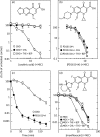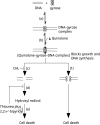Contribution of reactive oxygen species to pathways of quinolone-mediated bacterial cell death
- PMID: 20067982
- PMCID: PMC2818107
- DOI: 10.1093/jac/dkp486
Contribution of reactive oxygen species to pathways of quinolone-mediated bacterial cell death
Abstract
Background: Quinolone-mediated death of Escherichia coli has been proposed to occur by two pathways. One is blocked by inhibitors of protein synthesis; the other is not. It is currently unknown how these two pathways fit with the recent observation that hydroxyl radical accumulation is associated with quinolone lethality.
Methods: E. coli was treated with thiourea plus 2,2'-bipyridyl to block hydroxyl radical accumulation, and the effect on quinolone lethality was measured for quinolones that distinguished the two lethal pathways: oxolinic acid requires protein synthesis to kill E. coli, while PD161144, a C-8-methoxy fluoroquinolone, does not. The lethal activity of another fluoroquinolone, moxifloxacin, was partially blocked by the presence of chloramphenicol, an inhibitor of protein synthesis. That feature made it possible to determine whether the effects of chloramphenicol and thiourea plus 2,2'-bipyridyl were additive.
Results: Lethal activity of oxolinic acid was completely blocked by thiourea plus 2,2'-bipyridyl and by chloramphenicol. In contrast, PD161144 lethality was unaffected by these treatments. With moxifloxacin, both chloramphenicol and thiourea plus 2,2'-bipyridyl separately exhibited the same partial inhibition of quinolone lethality. No additivity in protection from moxifloxacin lethality was observed when thiourea, 2,2'-bipyridyl and chloramphenicol were combined and compared with the effect of chloramphenicol or thiourea plus 2,2'-bipyridyl used separately.
Conclusions: Inhibitor studies indicated that hydroxyl radical action contributes to quinolone-mediated cell death occurring via the chloramphenicol-sensitive lethal pathway but not via the chloramphenicol-insensitive pathway.
Figures


Similar articles
-
Inhibitors of reactive oxygen species accumulation delay and/or reduce the lethality of several antistaphylococcal agents.Antimicrob Agents Chemother. 2012 Nov;56(11):6048-50. doi: 10.1128/AAC.00754-12. Epub 2012 Sep 4. Antimicrob Agents Chemother. 2012. PMID: 22948880 Free PMC article.
-
Effect of anaerobic growth on quinolone lethality with Escherichia coli.Antimicrob Agents Chemother. 2007 Jan;51(1):28-34. doi: 10.1128/AAC.00739-06. Epub 2006 Oct 16. Antimicrob Agents Chemother. 2007. PMID: 17043118 Free PMC article.
-
Reactive oxygen species play a dominant role in all pathways of rapid quinolone-mediated killing.J Antimicrob Chemother. 2020 Mar 1;75(3):576-585. doi: 10.1093/jac/dkz485. J Antimicrob Chemother. 2020. PMID: 31793990
-
Moxifloxacin: a respiratory fluoroquinolone.Expert Opin Pharmacother. 2008 Jul;9(10):1755-72. doi: 10.1517/14656566.9.10.1755. Expert Opin Pharmacother. 2008. PMID: 18570608 Review.
-
Bacterial death from treatment with fluoroquinolones and other lethal stressors.Expert Rev Anti Infect Ther. 2021 May;19(5):601-618. doi: 10.1080/14787210.2021.1840353. Epub 2020 Nov 16. Expert Rev Anti Infect Ther. 2021. PMID: 33081547 Review.
Cited by
-
Involvement of Holliday junction resolvase in fluoroquinolone-mediated killing of Mycobacterium smegmatis.Antimicrob Agents Chemother. 2015 Mar;59(3):1782-5. doi: 10.1128/AAC.04434-14. Epub 2014 Dec 22. Antimicrob Agents Chemother. 2015. PMID: 25534729 Free PMC article.
-
YihE kinase is a central regulator of programmed cell death in bacteria.Cell Rep. 2013 Feb 21;3(2):528-37. doi: 10.1016/j.celrep.2013.01.026. Epub 2013 Feb 14. Cell Rep. 2013. PMID: 23416055 Free PMC article.
-
Induction of mycobacterial resistance to quinolone class antimicrobials.Antimicrob Agents Chemother. 2012 Jul;56(7):3879-87. doi: 10.1128/AAC.00474-12. Epub 2012 May 7. Antimicrob Agents Chemother. 2012. PMID: 22564842 Free PMC article.
-
Modulation of Reactive Oxygen Species Homeostasis as a Pleiotropic Effect of Commonly Used Drugs.Front Aging. 2022 Jun 14;3:905261. doi: 10.3389/fragi.2022.905261. eCollection 2022. Front Aging. 2022. PMID: 35821802 Free PMC article. Review.
-
Mutations in mmpL and in the cell wall stress stimulon contribute to resistance to oxadiazole antibiotics in methicillin-resistant Staphylococcus aureus.Antimicrob Agents Chemother. 2014 Oct;58(10):5841-7. doi: 10.1128/AAC.03501-14. Epub 2014 Jul 21. Antimicrob Agents Chemother. 2014. PMID: 25049248 Free PMC article.
References
-
- Chen C-R, Malik M, Snyder M, et al. DNA gyrase and topoisomerase IV on the bacterial chromosome: quinolone-induced DNA cleavage. J Mol Biol. 1996;258:627–37. - PubMed
-
- Malik M, Zhao X, Drlica K. Lethal fragmentation of bacterial chromosomes mediated by DNA gyrase and quinolones. Mol Microbiol. 2006;61:810–25. - PubMed
Publication types
MeSH terms
Substances
Grants and funding
LinkOut - more resources
Full Text Sources
Medical

